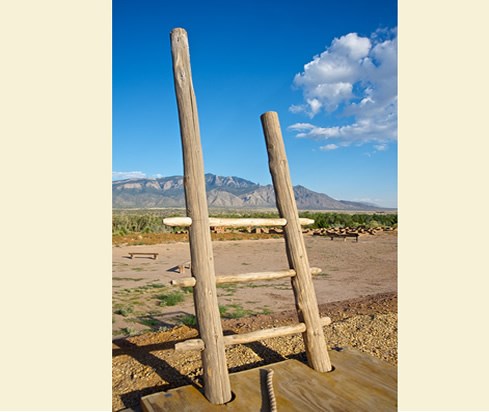Last updated: July 2, 2020
Article
New Mexico: Kuaua Ruins (Coronado Historic Site)

The legend of Francisco Vásquez de Coronado looms large in New Mexico history as one of the first European explorers to tread what became U.S. soil along sections of what would later be called El Camino Real de Tierra Adentro.
Coronado’s compatriot, Juan de Oñate, is widely remembered as the first Spaniard who blazed the northern arm of El Camino Real from Zacatecas to San Juan Pueblo, where he settled New Mexico in the name of Spain in 1598. But it was Coronado who first surveyed the area for the Spanish Crown a half-century earlier, setting the stage for other adventurers to explore the region’s rich and diverse cultural landscape.
Perhaps nowhere is Coronado’s impact more keenly recognized than at Kuaua Ruins, a precontact Tiwa village known since 1940 as Coronado Historic Site. Located a half-mile northwest of Bernalillo on the west banks of the Rio Grande, the earthen remnants of the multi-story Kuaua, which was settled around 1300 AD, lie west of the main route of El Camino Real. Even so, the physical and environmental vistas preserved at the site, and the stories it tells of the Pueblo life and culture that Coronado and others encountered, give Kuaua particular significance on the trail’s interpretive path of living history and experience.
Today, stands of giant yucca and awe-inspiring views of the Sandia Mountains and the Rio Grande bosque (woodland) transition visitors from the hectic car culture of nearby Albuquerque, New Mexico’s largest city, to the natural setting that Coronado first encountered in August 1540. Kuaua was then among the largest Pueblo Indian settlements in the region. While Coronado surely visited Kuaua, neither Spanish documents nor archeological evidence support the common assumption that his company spent the following winter there during an especially severe season that saw the Rio Grande freeze over and months of daily snowfall. Nonetheless, in exploring the middle river valley, frequently using long-established Indian trails, Coronado witnessed an age of Pueblo independence and prosperity that, by the end of the 16th century, would be entirely transformed.

Coronado’s 1,400-mile journey from Compostela to New Spain’s northern frontier served the Spanish Crown’s mission to exploit the region’s natural resources and convert its Native populations to Christianity. Accompanied by 400 Spanish soldiers, 1,000 Native American allies, six Franciscan friars, dozens of African slaves, and 1,500 horses, sheep, cattle and pigs, Coronado initially set his sight on Hawikúh, today’s Zuni Pueblo, a large western New Mexico settlement fabled to be constructed of gold. When his arrival at Hawikúh met fierce resistance, and legends of gold proved untrue, a missive from fellow soldier Pedro de Alvarado directed Coronado north to the thriving Tiwa communities of Tiguex province. Alvarado wrote:
“This river of Nuestra Señora [Our Lady] flows through a broad valley planted with fields of maize and dotted with cottonwood groves. There are 12 pueblos, whose houses are built of mud and are two stories high. They have a food supply of maize, beans, melons and turkeys in great abundance.”
When Coronado arrived, the Tiguex population was at its peak with more than 20,000 people settled along 30 miles of the Rio Grande. At the province’s northern end was Kuaua, Tiwa for “evergreen,” a wellspring of Native resourcefulness and ritual in a landscape replete with bear, wildcats, beaver and deer. First settled in the early 1300s and continually occupied through 1600, the pueblo spanned six acres of low terrace land and featured approximately 1,200 surface dwellings and storage rooms, six underground ceremonial kivas and three rectangular plazas. Doorways connected a few of the rooms, but most were entered via a ladder through a hatchway in the roof.
Coronado’s army struggled to endure the brutal winter of 1540-41, but residents of Kuaua and other Tiguex villages were well prepared. Under threat of force, some residents supplied the soldiers with animal skins, blankets, turkey and corn. By 1542, however, Coronado had failed to wrest control over the Tiguex pueblos or to discover valuable mineral stocks. Come spring, he abandoned the area to seek his fortunes in Texas and on the Kansas Plains.

Between 1934 and 1940, as a joint project the University of New Mexico, Museum of New Mexico and the School of American Research excavated Kuaua. The ruins were reconstructed and an educational site was developed featuring a museum and Spanish-Pueblo Revival-style visitor center designed by renowned Southwest architect John Gaw Meem. While most of the excavated areas were reburied for protection, several room blocks and kivas were rebuilt on the village footprint to replicate the original layout. Among the most notable restorations was Kiva 3, commonly known as the Painted Kiva, where 17 layers of wall murals were removed and preserved and reproduction murals were painted on its reconstructed interiors.
Like its precontact predecessor, much of Kuaua has now settled back into the earth. Even so, for visitors who wander through the ruins along an interpretive trail, explore the museum and visitor center, or take in the pristine views from a shady portal or picnic tables, the Kuaua experience illuminates Pueblo Indian culture from the precontact period to early Spanish contact. Established long before such other American first-contact sites as Jamestown or Plymouth Rock, Kuaua literally grounds visitors in the past, linking ancient Puebloans to modern-day Tiwa peoples who remain central to the cultural fabric of New Mexico and the Southwest.
Kuaua Ruins at Coronado Historic Site is located at 485 Kuaua Rd. in Bernalillo, NM.
Explore more history by visiting the El Camino Real travel itinerary website.

